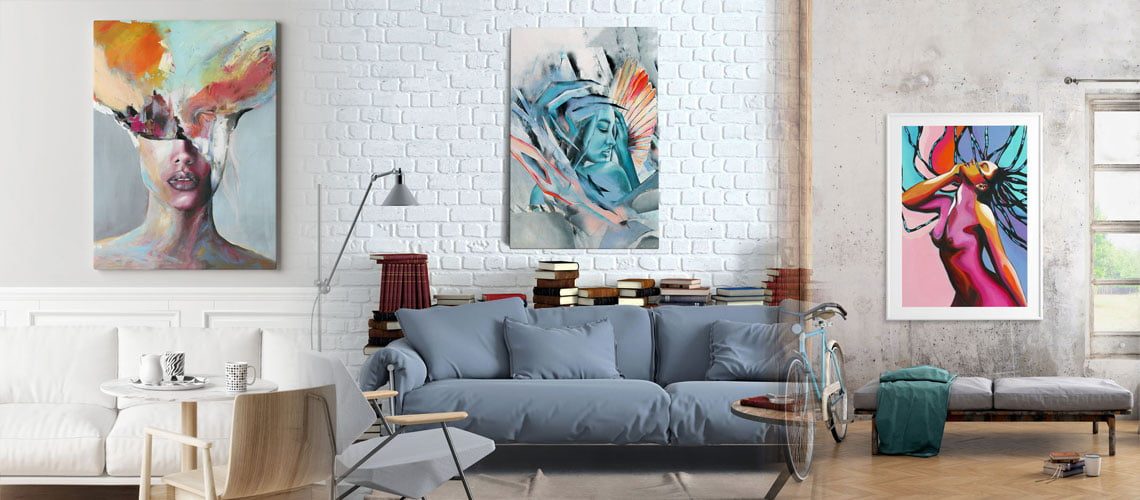What do Andy Warhol, Mark Rothko, David Hockney and Roy Lichtenstein have in common? You might not know that all of them used acrylic paint. Acrylic painting is executed in the medium of synthetic acrylic resins. It became particularly popular in the 1960s, mainly because it dries rapidly. It’s a great vehicle for any kind of pigment and is usually less affected by heat and other destructive forces than oil paint.
Some more information about acrylic painting
Acrylic paint is paint made of pigment suspended in acrylic emulation. It becomes water-resistant once dry. Artists also appreciate the fact that acrylic paint is surprisingly versatile. It can resemble a watercolor, an oil painting or gouache, depending on how much paint is diluted with water. Art experts say that acrylic painting altered the world of the plastic arts and that’s true. One of the first artists who used acrylic paint on a large scale was Diego Rivera, the Mexican muralist. By the 1950s acrylic painting became commercially available. Now, it is used on paper, canvas and a range of other materials (including hobby models). The most important thing, besides its versatility, is that acrylic paint dries almost immediately. Thanks to that an artist can work in multiple successive layers without muddying the colors. Moreover, the artist can dilute the paint with water and use it as a watercolor.
Abstract acrylic painting
What do you see on abstract art? Some people see an array of colorful patterns, others see a flowing river and others… cosmic flow and pure energy. Acrylic painting is just a perfect match for abstract art. It enables artists to create timeless, open-to-interpretation pieces of art. Abstract acrylic painting is the freedom to explore the artwork, a way to enrich a viewer’s experience. Abstract acrylic painting is a perplexing art form that evades artistic classification. If you are looking for wall art that pulls a depiction away from any literal reference points, abstract acrylic painting might be your best choice.
Acrylic painting ideas
A really cool thing about acrylic painting is that it’s a perfect choice for beginners. So, if you want to try yourself in becoming a painter, acrylic paint is easy to use and forgiving. Any mistake you can easily paint over once it dries. Acrylic paint is also medium-friendly – you can test many different options to achieve various effects.
What are acrylic paint ideas to try with mediums then? If you want to create thin, even layers of paint or achieve a high level of transparency, try with gel medium. It perfectly works as a medium for collages. If you use texture medium, you can experiment with the likes of modeling paste, beads and sand (perfect for depicting landscapes!). Flow medium is best for acrylic staining or pouring and slow-drying medium – for copying masterpiece oil paintings that you admire. Want some more acrylic painting ideas? Try painting retro-inspired flowers, learn a bubble painting technique or use a palette knife for an abstract painting. The options are endless!
Acrylic paintings for sale
Okay, if you’re not an artist who wants to try acrylic techniques yourself, you can still spoil yourself with some outstanding acrylic painting. From abstract to figurative, from portraits to landscapes, acrylic painting’s versatility satisfies the needs of even the most demanding customers. When compared to other paint mediums, modern acrylic paint has many advantages. I have already mentioned that it’s versatile and dries really quickly. On top of that, it’s water-soluble and less toxic than other mediums. It’s affordable so one might find acrylic paintings for sale at very reasonable prices.
Acrylic techniques
Acrylic painting combines the best of oil paints (like creamy texture) with the best of watercolors (like quick-drying and easy clean-up). It is multifunctional and allows to create art in various forms. You can create on canvas, wood, glass, paper, fabric etc. The most popular acrylic painting techniques are:
- Dry brush – easy to execute, creates textured, uneven movement of lines. Perfect for acrylic painting on canvas. The brush should be as dry as possible.
- Washing – you apply the medium in thick layers and create a thin, translucent hue. This technique enables you to elicit a softness that resembles watercolor.
- Stippling – this technique is the creation of many tiny dots. It’s often used in landscape painting.
- Splattering – this technique relies on applied energy to achieve its aesthetic. If you want to try splattering, use a wet brush, dip the bristles in paint and direct the brush in the direction of the canvas.
- Dabbing – this technique is used to ‘dab’ accents of color onto the surface of a canvas. You should use a stiff brush to apply the paint with light pressure. This method adds movement to acrylic paintings on canvas.
- Sponging – it’s a bit similar to dabbing. However, this technique requires a cellulose sponge to apply paint in a springing motion. The movement creates a textured pattern.
Check out more articles:





